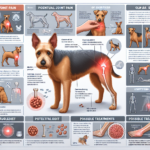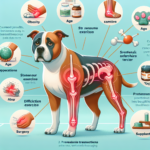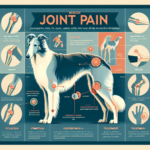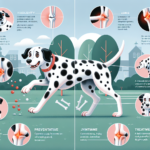Manchester Terrier Joint Pain: Causes, Symptoms, Prevention, and Treatment

Introduction
The Manchester Terrier is a small, sleek, and elegant breed known for its agility, intelligence, and spirited nature. Originating in England, this breed was initially developed in the 19th century for ratting and rabbit hunting. The Manchester Terrier comes in two varieties: the Toy and the Standard, both of which share a similar appearance but differ in size. With their keen senses and energetic disposition, Manchester Terriers make excellent companions and watchdogs.
Like many breeds, Manchester Terriers are prone to certain health issues. Among these, joint pain is a significant concern that can affect their quality of life. Joint health is crucial for maintaining the breed’s active lifestyle and overall well-being. Understanding the causes, symptoms, prevention, and treatment of joint pain in Manchester Terriers is essential for owners who wish to ensure their pets lead healthy, pain-free lives.
Breed-Specific Joint Pain Risks
Genetic Predisposition
Manchester Terriers, like many purebred dogs, can be genetically predisposed to joint-related issues. Common conditions include hip dysplasia, arthritis, and elbow dysplasia. Hip dysplasia occurs when the hip joint does not fit properly into the hip socket, leading to pain and mobility issues. Arthritis, a degenerative joint disease, can cause inflammation and pain in the joints. Elbow dysplasia, a condition where the elbow joint develops abnormally, can also lead to significant discomfort and lameness.
Age-Related Risks
As Manchester Terriers age, the risk of developing joint pain increases. While younger dogs may show few signs of joint issues, older dogs are more susceptible to conditions like arthritis. Owners should be vigilant as their Manchester Terrier approaches middle age, typically around 6-8 years, and continue to monitor for signs of joint pain as the dog ages further.
Activity Level and Joint Stress
Manchester Terriers are known for their high energy levels and love for physical activity. While regular exercise is essential for their overall health, excessive or inappropriate exercise can lead to joint stress. Activities that involve a lot of jumping or sudden stops and starts can be particularly hard on their joints. Owners should balance their dog’s need for exercise with the potential risk of joint damage.
Common Symptoms of Joint Pain in Manchester Terriers
General Symptoms
- Limping or favoring one leg
- Stiffness, especially after rest
- Reluctance to jump, run, or climb stairs
- Decreased activity or playfulness
- Visible discomfort or pain when touched
- Swelling around the joints
Breed-Specific Symptoms
In Manchester Terriers, joint pain may manifest more subtly due to their stoic nature. Owners might notice a decrease in the dog’s usual enthusiasm for play or a reluctance to engage in activities that were previously enjoyed. Additionally, changes in gait or posture can be early indicators of joint pain in this breed.
When to Consult a Vet
If any of the above symptoms are observed, it is crucial to consult a veterinarian. Early diagnosis and treatment can significantly improve the dog’s quality of life and prevent further joint damage. Persistent limping, noticeable pain, or any sudden changes in behavior should prompt an immediate veterinary visit.
Preventive Measures for Joint Health
Exercise Recommendations
Regular, moderate exercise is key to maintaining joint health in Manchester Terriers. Activities such as walking, swimming, and controlled play are excellent choices. Avoid high-impact exercises that involve a lot of jumping or abrupt movements. Consistent, low-impact exercise helps keep the joints flexible and muscles strong without causing undue stress.
Dietary Suggestions
A balanced diet rich in essential nutrients supports overall health and joint function. Foods containing glucosamine, chondroitin, and omega-3 fatty acids can be particularly beneficial for joint health. These nutrients help reduce inflammation and support cartilage repair. Owners should consult their veterinarian for specific dietary recommendations and consider supplements if necessary.
Weight Management
Maintaining a healthy weight is crucial for reducing joint stress. Excess weight puts additional pressure on the joints, exacerbating pain and potentially leading to further damage. Owners should monitor their Manchester Terrier’s weight and adjust their diet and exercise routine as needed to keep them at an optimal weight.
Early Screening and Monitoring
Regular veterinary check-ups are essential for early detection of joint issues. Screening tests such as X-rays or joint fluid analysis can help identify problems before they become severe. Early intervention can slow the progression of joint diseases and improve the dog’s quality of life.
Treatment Options for Joint Pain
Non-Surgical Treatments
Non-surgical treatments for joint pain in Manchester Terriers include medications, physical therapy, and lifestyle adjustments. Anti-inflammatory drugs and pain relievers can help manage symptoms. Physical therapy, including exercises and massage, can improve joint function and reduce pain. Lifestyle adjustments, such as providing a comfortable bed and avoiding strenuous activities, can also make a significant difference.
Surgical Options
In severe cases, surgical intervention may be necessary. Common surgeries for joint pain include hip replacement, arthroscopy, and joint fusion. These procedures can provide significant relief and improve mobility. However, surgery should be considered a last resort after exploring all non-surgical options.
Alternative Therapies
Alternative treatments such as acupuncture, hydrotherapy, and massage can also benefit Manchester Terriers with joint pain. Acupuncture can help reduce pain and inflammation, while hydrotherapy provides low-impact exercise that strengthens muscles without stressing the joints. Regular massage can improve circulation and reduce muscle tension around the affected joints.
Lifestyle and Management Tips
Daily Care Routine
A daily care routine for a Manchester Terrier with joint pain might include gentle exercise, a balanced diet with joint-supporting supplements, and regular physical therapy sessions. Providing a comfortable, supportive bed and ensuring the dog has easy access to food, water, and favorite resting spots can also help manage pain.
Modifying the Home Environment
Making the home environment more comfortable for a dog with joint pain involves minimizing the need for jumping or climbing. Ramps can be used to help the dog access furniture or get in and out of the car. Orthopedic beds provide better support for sore joints, and non-slip mats can prevent falls on slippery floors.
Long-Term Management
Long-term management of joint pain in Manchester Terriers involves regular veterinary check-ups, consistent exercise, and a healthy diet. Owners should remain vigilant for any changes in their dog’s behavior or mobility and adjust their care routine as needed. With proper management, dogs with joint pain can continue to lead active, happy lives.
FAQs About Manchester Terriers and Joint Pain
What are the early signs of joint pain in Manchester Terriers?
Early signs of joint pain include limping, stiffness, reluctance to move, and decreased activity levels. Owners may also notice changes in gait or posture.
Can joint pain in Manchester Terriers be prevented?
While genetic predispositions cannot be entirely prevented, maintaining a healthy weight, providing appropriate exercise, and ensuring a balanced diet can significantly reduce the risk of joint pain.
Are there specific exercises that are better for Manchester Terriers with joint pain?
Low-impact exercises such as walking and swimming are ideal for Manchester Terriers with joint pain. These activities help maintain joint flexibility and muscle strength without causing additional stress.
What dietary supplements are recommended for joint health in Manchester Terriers?
Supplements containing glucosamine, chondroitin, and omega-3 fatty acids are beneficial for joint health. These nutrients help reduce inflammation and support cartilage repair.
When should I consider surgery for my Manchester Terrier’s joint pain?
Surgery should be considered when non-surgical treatments are no longer effective, and the dog’s quality of life is significantly impacted. Consult with a veterinarian to determine the best course of action.
Conclusion
Joint pain is a common issue that can significantly affect the quality of life of Manchester Terriers. By understanding the causes, symptoms, prevention, and treatment options, owners can take proactive steps to ensure their pets remain healthy and active. Regular veterinary check-ups, appropriate exercise, a balanced diet, and weight management are crucial for maintaining joint health. Early intervention and proper management can help Manchester Terriers lead happy, pain-free lives.
Owners are encouraged to consult their veterinarian regularly and take preventive measures to support their dog’s joint health. With the right care and attention, Manchester Terriers can continue to enjoy their energetic and spirited nature well into their senior years.




